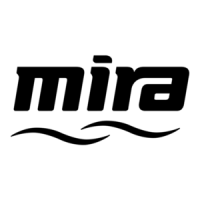10
1.4 Avoid layouts where the shower hose will be sharply kinked. This may reduce
the life of the hose.
1.5 Supply pipework MUST be ushed to clear debris before connecting the
appliance. Debris will reduce the performance of the shower and may damage
the product.
Avoid running the pipework through excessively hot or cold areas such as hot
loft spaces, airing cupboards, or in close proximity to hot water pipes. If this
cannot be avoided, we would recommend insulating the pipes.
1.6 The shower must be tted onto a tiled or sealed nished surface, i.e. on top of
the tiles: [DO NOT tile up to the sides of the shower or use a sealant around the
case.] Failure to do this may cause appliance failure. To ensure the case and
other components are not put under strain during installation always provide
mechanical support when making plumbing connections. Upon completion of
the installation ensure connections and back case are not under any stress
due to misaligned pipework or electrical cables.
1.7 We recommend that a non-restrictive (free owing) isolating valve is tted in
the cold water supply pipe to allow maintenance of the appliance.
1.8 When installed in very hard water areas (above 200 ppm temporary hardness)
your installer may advise the installation of a water treatment device, to reduce
the effects of limescale formation. Any malfunction due to limescale is not
covered by the manufacturer's guarantee. Your local water company will be
able to advise the hardness of water in your area.
Hose Retaining Ring tted and shower ttings xed at a suitable height preventing
dirty water backow.
Zone of
Backow Risk
30 mm
Minimum
Toilet or Bidet
FC5
Hand Basin
FC3
Bath or Shower
Tray FC3
Electric
Shower
25 mm
Minimum
25 mm Minimum

